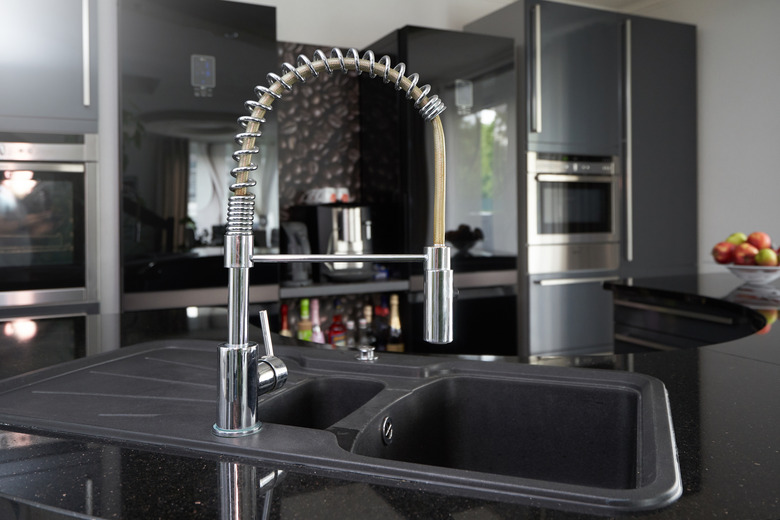How To Clean A Pull-Down Kitchen Faucet Spray Head
When you get low water flow from your kitchen pull-down faucet, there could very well be a blockage in the spray head. This is usually caused by calcium deposits in the aerator, inlet screen or backflow preventer, and vinegar will dissolve buildup in all of these. However, you should check first that the spray head is actually the source of the problem, because sometimes the real culprit is a component of the faucet you wouldn't normally suspect: the quick-connect fitting between the spray head hose and the faucet body.
Clean the Aerator
Clean the Aerator
The aerator is that little screen you see in a conventional kitchen faucet spout that infuses the water with air and converts it to a packet of small streamlets. Spray heads also have aerators, although the location depends on the make of the faucet. Most are installed inside the hose or spray head at the point where the hose connects to the spray head, but some manufacturers, such as [Kohler](https://support.kohler.com/hc/en-us/articles/360001048134-Remove-the-Aerator-for-the-Simplice-Pull-Down-Faucet#:~:text=%E2%80%8BThe%20aerator%20is%20located,turn%20the%20wrench%20counterclockwise%20(Fig.), put the aerator in the face of the spray head.
To remove an aerator at the base of the spray head, pull out the spray head, anchor the hose with a clothespin or small clamp so it doesn't retract, then unscrew the head, which you can usually do by hand. The aerator is either inside the hose connector or in the spray head, and you can pry it out with a flat-head screwdriver. To remove an aerator in the spray face, you usually have to unscrew it with an adjustable wrench.
Hold the aerator under a stream of water and remove sediment with a sponge, as American Standard demonstrates in this YouTube video. In most cases, that's all the cleaning your spray head needs.
Deep Clean the Spray Head
Deep Clean the Spray Head
When the spray head has been in service for a long time, mineral deposits can collect inside the holes on the spray face and in internal parts, such as the backflow preventer. It's impractical to disassemble the spray head to clean these deposits off every part, and, fortunately, you don't have to. All you need is some distilled white vinegar and a bowl large enough to submerge the spray head.
Soak the entire spray head, including the aerator, for several hours and preferably overnight. When you retrieve the spray head, rinse it under clean water, then reattach it to the faucet, and you should get normal flow from the faucet.
Spray Head Not the Problem
Spray Head Not the Problem
When you unscrew the spray head for cleaning, open the faucet and watch the water flowing from the hose. If you don't see a full, steady stream, it doesn't hurt to clean the spray head anyway, but the obstruction is deeper in the pipes, and the most likely place, believe it or not, is the quick-connect fitting at the other end of the faucet hose. This plastic connector, which comes with many pull-down faucets, can get blocked with mineral deposits. You can also clean it with vinegar.
To locate the quick-connect fitting, go inside the cabinet with a headlamp and follow the faucet hose from the point it exits the spout tube until you find the connection to the faucet body. Disconnect it by squeezing the tabs and pulling it apart, then unscrew it from the spray hose using pliers. Soak it for several hours in vinegar, replace it, and the flow should be restored.
